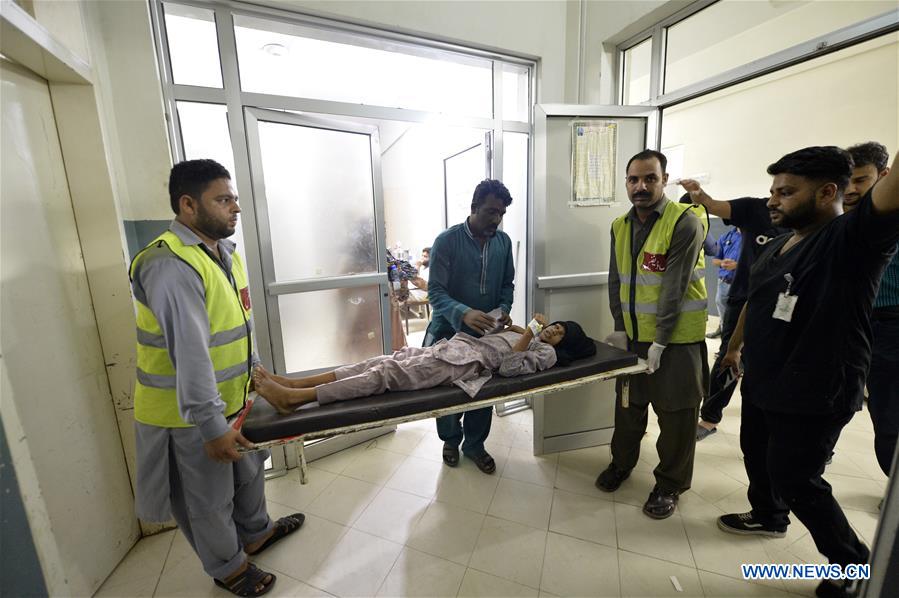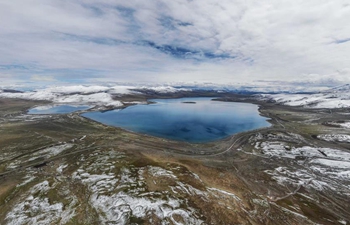 ?
?Rescuers transfer an injured child to a hospital in Mirpur district of the Pakistan-controlled Kashmir on Sept. 24, 2019. The death toll from a 5.8-magnitude earthquake jolting parts of Pakistan and Pakistan-controlled Kashmir on Tuesday rose to 28, and at least 476 others were injured, officials and local media said Wednesday morning. (Xinhua/Ahmad Kamal)
ISLAMABAD, Sept. 25 (Xinhua) -- The death toll from a 5.8-magnitude earthquake jolted parts of Pakistan and Pakistan-controlled Kashmir on Tuesday rose to 28, and at least 476 others were injured as the rescue work still on, officials and local media said Wednesday morning.
According to a statement from the spokesperson of the Interior Ministry of the Pakistan-controlled Kashmir, 26 people were killed and 456 others injured in Mirpur district of the Pakistan-controlled Kashmir, bordering Pakistan's eastern Punjab province.
At least two women were killed and 20 others wounded in two different incidents of wall-collapsing in eastern districts of Jhelum and Lahore, the reports said.
The earthquake hit parts of Pakistan with its epicenter was determined with a depth of 10 km at 5 km north of Jhelum district located some 119 km southeast of capital Islamabad.
The jolts were also felt in Islamabad and different areas of Punjab and northwest Khyber Pakhtunkhwa provinces where people rushed out of buildings to open places.
Soon after the earthquake, civil and military rescue teams rushed to the affected areas to help victims. The Inter-Services Public Relations (ISPR), the media wing of the Pakistan army, said that an immediate rescue operation in aid of civil administration for victims of the earthquake had started as army troops with aviation and medical support teams reached the affected areas.
Later in the evening, the ISPR said the army aviation helicopters had completed an aerial survey for damage assessment and to guide the teams at the ground.
Deputy Inspector General of Police in Mirpur Sardar Gulfaraz feared that the death toll might further rise as scores of others are still buried under the debris in different areas.
Chairman of the National Disaster Management Authority (NDMA) Lt. General Muhammad Afzal told a press conference in Islamabad on Tuesday evening that rescue teams equipped with special gadgets to trace trapped people under the debris have started work.
The NDMA chairman said food items, medicines, medics, quilts, tents and generators have been sent to the affected areas, adding that they are preparing to protect the displaced people from the forecasted rain spell coming in next few days.
Jatlan town is the worst-hit area in Mirpur where dozens of houses, plazas and shops collapsed and it was disconnected from other areas due to severe damages to the road network, including three bridges.
Minister for Youth and Culture of Pakistan-controlled Kashmir Muhammad Saeed told Xinhua that serious damages have done to the infrastructure, communication network and electricity supply, which has disrupted daily life in the district.
The minister added that at least 2-km long road skidded into an adjacent canal and several vehicles moving at the road also fell and drowned into the canal.
An eyewitness from Mirpur named Atiq-ur-Rehman told Xinhua that big cracks have appeared at roads in the district, which have disrupted the movement.
A resident of Mirpur named Talat told Xinhua that the intensity of the jolts was very high which forced them to rush out of their houses, adding that a wall of his house collapsed and pressed his car. The local added that the majority of the houses in his neighborhood got damaged with serious cracks.
A multistorey hostel building of a medical college also collapsed in Mirpur and killed one student when he jumped from the roof of the trembling building.
Several villages located at the nearby mountainous areas were also affected where locals are conducting the rescue work as rescue teams could not reach there.
A couple of villages were inundated after a bank of the canal was broken, but authorities stopped water supply to the canal and moved villagers to safe places.
Soon after the earthquake, Pakistan's Water and Power Development Authority (WAPDA) closed all the turbines of the Hydropower Station Mangla established at the River Jhelum near Mirpur but the production was resumed on later Tuesday night.
Locals told Xinhua that the public hospitals in the area lacks the capacity to handle hundreds of injured forcing dozens of wounded to lie under the open sky for treatment. The deputy commissioner told media that they are moving seriously injured to hospitals in neighboring districts, capital Islamabad and garrison city of Rawalpindi.
The NDMA also asked people in a public message to take necessary precautionary measures to avoid possible losses in case of aftershocks. The country's seismic center said that an aftershock of 3.4-magnitude was also recorded in 6 km north of Jhelum fearing that more aftershocks might come as the area is located at the active fault line.
Pakistani President Arif Alvi and Prime Minister Imran Khan expressed their sorrows over the losses and instructed the authorities concerned to take quick and special measures to provide relief to the victims.
Pakistan has a history of serious earthquakes, as it is located at one of the most earthquake-prone areas with high vulnerability to earthquakes.
In October 2005, a 7.6-magnitude earthquake hit Pakistan and resulted more than 86,000 people killed.











